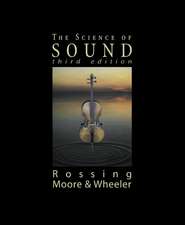The Physics of Music and Color
Autor Leon Guntheren Limba Engleză Paperback – 8 dec 2014
The Physics of Music and Color is written at level suitable for college students without any scientific background, requiring only simple algebra and a passing familiarity with trigonometry. It contains numerous problems at the end of each chapter that help the reader to fully grasp the subject.
| Toate formatele și edițiile | Preț | Express |
|---|---|---|
| Paperback (2) | 506.63 lei 6-8 săpt. | |
| Springer International Publishing – 4 noi 2020 | 506.63 lei 6-8 săpt. | |
| Springer – 8 dec 2014 | 709.91 lei 6-8 săpt. | |
| Hardback (1) | 569.48 lei 38-44 zile | |
| Springer International Publishing – 4 noi 2019 | 569.48 lei 38-44 zile |
Preț: 709.91 lei
Preț vechi: 835.18 lei
-15% Nou
Puncte Express: 1065
Preț estimativ în valută:
135.84€ • 148.02$ • 114.47£
135.84€ • 148.02$ • 114.47£
Carte tipărită la comandă
Livrare economică 23 aprilie-07 mai
Preluare comenzi: 021 569.72.76
Specificații
ISBN-13: 9781493902149
ISBN-10: 1493902148
Pagini: 564
Ilustrații: XXII, 540 p.
Dimensiuni: 155 x 235 x 30 mm
Greutate: 0.78 kg
Ediția:2012
Editura: Springer
Colecția Springer
Locul publicării:New York, NY, United States
ISBN-10: 1493902148
Pagini: 564
Ilustrații: XXII, 540 p.
Dimensiuni: 155 x 235 x 30 mm
Greutate: 0.78 kg
Ediția:2012
Editura: Springer
Colecția Springer
Locul publicării:New York, NY, United States
Public țintă
Lower undergraduateCuprins
Preface.- Introductory Remarks.- The Vibrating String.- The Vibrating Air Column.- Energy.- Electricity, Magnetism, and Electromagnetic Waves.- The Atom as a Source of Light.- The Principle of Superposition.- Propagation Phenomena.- The Ear.- Psychoacoustics.- Tuning, Intonation, and Temperament - Chooising Frequencies for Musican Notes.- The Eye.- Characterizing Light Sources, Color Filters and Pigments.- Theory of Color Vision.- Appendices.
Notă biografică
Leon Gunther has been on the Physics Department faculty at Tufts University since 1965. He got his PhD in Physics from MIT in 1964 and has published over 100 articles, the vast majority being in the field of Condensed Matter Theory. Having begun studies of the violin at the age of seven, he has played in numerous Community Symphony Orchestras, most notably the Newton Symphony, where he was the principal second violinist for ten years, from 1974-1984. In 1994, he founded the community chorus of Temple Emunah in Lexington, MA, known as the Mak'haylah. Programs include music of a wide range of genres - folk, liturgical, and classical. His compositions and arrangements include Hebrew renditions of three movements of the Brahms Requiem.
Textul de pe ultima copertă
The Physics of Music and Color deals with two subjects, music and color - sound and light in the physically objective sense - in a single volume. The basic underlying physical principles of the two subjects overlap greatly: both music and color are manifestations of wave phenomena, and commonalities exist as to the production, transmission, and detection of sound and light. This book aids readers in studying both subjects, which involve nearly the entire gamut of the fundamental laws of classical as well as modern physics. Where traditional introductory physics and courses are styled so that the basic principles are introduced first and are then applied wherever possible, this book is based on a motivational approach: it introduces a subject by demonstrating a set of related phenomena, challenging readers by calling for a physical basis for what is observed. The book is based upon a course on the physics of music and color that has been taught at Tufts University since 1973, when the course was introduced by Gary Goldstein and the author.
Topics that are unusual for a book at this level and breadth include: a detailed non-mathematical summary of the principles of electricity and magnetism with the goal of understanding the basis for various audio devices as well as the physical essence of light and how it propagates as a wave; extensive details on the calculation of color coordinates from a spectral intensity with different choices of primaries; the relationship between color coordinates on a computer and the color seen on a monitor. References to recent developments include the connection between the blueness of the ocean and the psycho-acoustic perception of combination tones in a sound wave. A major goal is to provide an understanding of basic principles, both conceptual and quantitative, that will allow the reader to have increased awareness of audial and visual experiences and to understand phenomena not discussed in the book.
ThePhysics of Music and Color is written at a level suitable for college students without any scientific background, requiring only simple algebra and a passing familiarity with trigonometry. It contains numerous problems at the end of each chapter that help the reader to fully grasp the subject. The book can also serve as a reference of basic principles for those involved in sound production and color management.
About the Author
Leon Gunther has been on the Physics Department faculty at Tufts University since 1965. He got his PhD in Physics from MIT in 1964 and has published over 100 articles, the vast majority being in the field of Condensed Matter Theory. Having begun studies of the violin at the age of seven, he has played in numerous Community Symphony Orchestras, most notably the Newton Symphony, where he was the principal second violinist for ten years, from 1974-1984. In 1994, he founded the community chorus of Temple Emunah in Lexington, MA, known as the Mak'haylah. Programs include music of a wide range of genres - folk, liturgical, and classical. His compositions and arrangements include Hebrew renditions of three movements of the Brahms Requiem.
Topics that are unusual for a book at this level and breadth include: a detailed non-mathematical summary of the principles of electricity and magnetism with the goal of understanding the basis for various audio devices as well as the physical essence of light and how it propagates as a wave; extensive details on the calculation of color coordinates from a spectral intensity with different choices of primaries; the relationship between color coordinates on a computer and the color seen on a monitor. References to recent developments include the connection between the blueness of the ocean and the psycho-acoustic perception of combination tones in a sound wave. A major goal is to provide an understanding of basic principles, both conceptual and quantitative, that will allow the reader to have increased awareness of audial and visual experiences and to understand phenomena not discussed in the book.
ThePhysics of Music and Color is written at a level suitable for college students without any scientific background, requiring only simple algebra and a passing familiarity with trigonometry. It contains numerous problems at the end of each chapter that help the reader to fully grasp the subject. The book can also serve as a reference of basic principles for those involved in sound production and color management.
About the Author
Leon Gunther has been on the Physics Department faculty at Tufts University since 1965. He got his PhD in Physics from MIT in 1964 and has published over 100 articles, the vast majority being in the field of Condensed Matter Theory. Having begun studies of the violin at the age of seven, he has played in numerous Community Symphony Orchestras, most notably the Newton Symphony, where he was the principal second violinist for ten years, from 1974-1984. In 1994, he founded the community chorus of Temple Emunah in Lexington, MA, known as the Mak'haylah. Programs include music of a wide range of genres - folk, liturgical, and classical. His compositions and arrangements include Hebrew renditions of three movements of the Brahms Requiem.
Caracteristici
Deals with related subjects of sound and light in one volume No scientific background and little mathematical background required Motivational approach to physics learning Teaches students how to respond to physical phenomena by searching for a deeper appreciation of what is observable Includes supplementary material: sn.pub/extras















